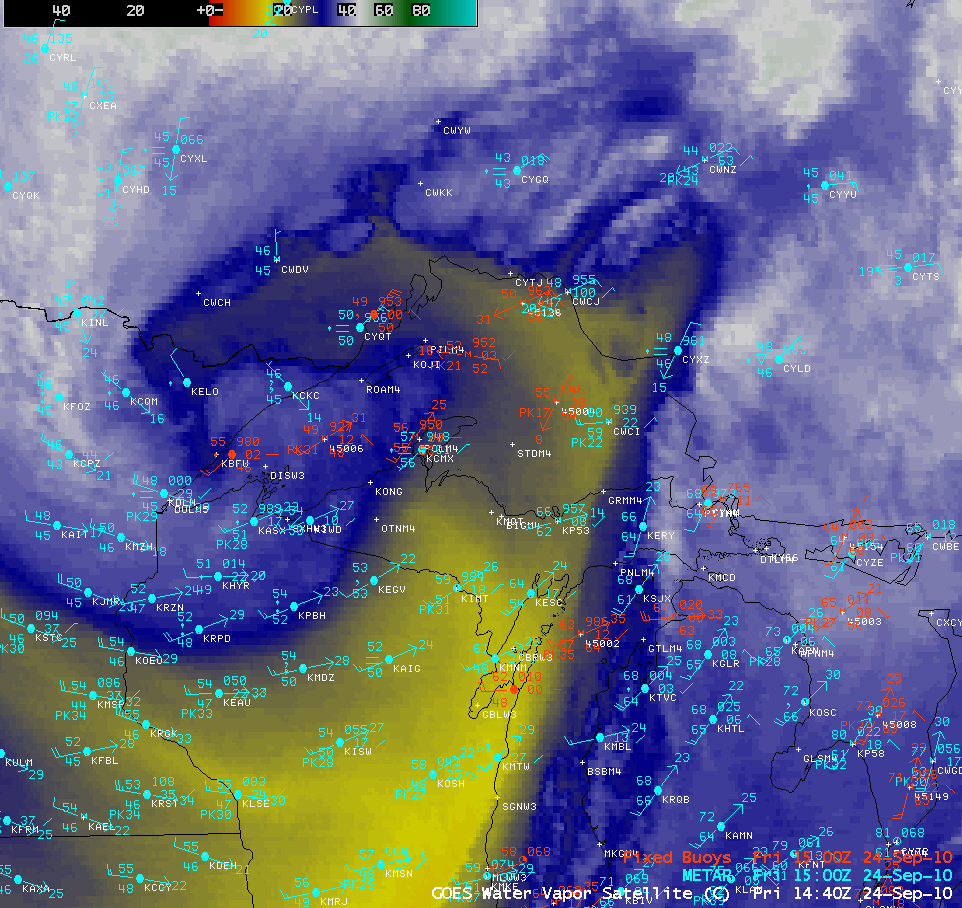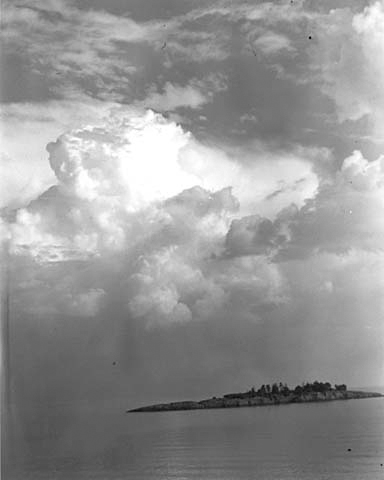Hundreds of ships have sunk in Lake Superior, the largest, coldest and deepest of the Great Lakes. But unless you’re a maritime history buff, you can probably name only one: the Edmund Fitzgerald, which sank during a storm near Whitefish Point, Michigan on the night of Nov. 10, 1975, killing all 29 aboard.
The reason you’ve likely heard of the Edmund Fitzgerald isn’t because it was the deadliest Great Lakes wreck. It’s because the story was memorialized in haunting detail in Gordon Lightfoot’s 1976 song, “The Wreck of the Edmund Fitzgerald,” which tells the tale of what happened to the captain and crew of the Edmund Fitzgerald when “the gales of November came early.”
If you’ve been to the North Shore during Lake Superior’s meanest season, late in the year, you probably have a sense of what Lightfoot is talking about. During gloomy, gusty fall storms, the lake spits out towering whitecaps that break across its rocky shorelines.
But what are the gales of November? And did they come early, as Lightfoot says in the song, when they sunk the Edmund Fitzgerald on that night 46 years ago?
A ‘hurricane’ west wind
By definition, a gale — of November or otherwise — occurs when wind speeds reach between 34 and 47 knots, or roughly 40 to 54 miles per hour.
When gales occur on Lake Superior, they’re typically caused by a weather phenomenon called a mid-latitude cyclone.
“The cyclone part, that’s anytime you have strong winds circling in counterclockwise around a low-pressure system,” said John Swenson, an associate professor at the University of Minnesota-Duluth’s Department of Earth and Environmental Sciences. Swenson has spent a lot of time watching Lake Superior react to changes in the weather; he grew up on the lake and talked to MinnPost from his childhood home, where he now lives.
The mid-latitude cyclone is basically the equivalent of a less-powerful continental hurricane. On a satellite, it even looks a lot like a hurricane. “You get the spiraling winds. Very beautiful, aesthetically, but kind of apocalyptic,” Swenson said.
Mid-latitude cyclones cover much larger areas than tropical cyclones, but they’re less intense. “They fill up basically the entire continent of North America, to some extent, when they’re fully developed” Swenson said. “Their winds are not as strong but if you’re on the lake they’re still plenty strong.”

On average, the center of the storms that form in this part of the country pass just south of Lake Superior. As a result, the winds are very strong over the lake, which also presents little in terms of obstacles for the wind, generating huge wave fields, Swenson said — and gales.
Wind makes big and unpredictable waves. A lot of factors determine how big the waves on the lake are, including where the wind is coming from and how far it blows across the lake. But waves nearly 30 feet high have been recorded on Lake Superior.

“Wind-driven waves on the Great Lakes, the period in between those waves is much shorter. And so it may only have a couple of seconds before the next wave comes rolling in. On top of you. So it’s a different environment than a lot of what you see on the ocean,” he said.
The gales of November come early
But when it comes to Superior gales, is November 10 really early, as Lightfoot claims at the end of his song’s first verse?

The windiest month by far on Lake Superior is November, Zika said. For example, if you look — even at the land-based observation station near Whitefish Point, Michigan — at big wind events by month, there are more of them in November than any other month.
But drilling down more specifically within the month of November, Lightfoot may be on to something. Swenson did some back-of-napkin math on a 30-year-old storms dataset, finding the most intense storms in the Duluth area.
“I wouldn’t hang my hat on it, but I came up with an average date for the top 20 [fall shoulder season storms] of about the 24th of November,” he said. Granted, the dataset covers the Duluth area — not the eastern part of the lake.
“So he’s not wrong. Not that we should ever question Gordo,” Swenson said.
The witch of November
Though surely the most famous, the Edmund Fitzgerald isn’t the only ship to have fallen victim to the Great Lakes’ November weather patterns. In 1905, the late-November Mataafa storm sunk or damaged 29 ships. In November 1913, the Great Lakes Storm sank at least 12 ships.
What makes November such a dangerous time? It’s not just that the weather is bad. It’s also that it’s a busy time on the Great Lakes. November is historically toward the end of shipping season (now it’s more like early January), said Carrie Sowden, archeological director at the National Museum of the Great Lakes in Toledo, Ohio.
“Shipping companies are trying to finish up their season and get in as much as they can,” she said.

And in fact, just what caused the Edmund Fitzgerald to go down is still a subject of debate. Sowden ran through the dominant theories. One possibility is the ship hit some underwater shoals that split the hull open. In 20 foot waves, it’s unlikely the sailors would have even noticed, she said. Another, mostly disproven — but that Lightfoot cites in the original version of the song — is that a hatch caved, letting water in. (In later versions of the song, Lightfoot changed the lyrics to remove the reference to the hatchway.) A third theory posits there was a problem with the steel or the welding on the ship’s hull. A sister ship was laid up a few years after the Edmund Fitzgerald sank because of stress fractures in its hull.
From the radio transcripts between the Edmund Fitzgerald and the Anderson, it’s clear the Edmund Fitzgerald was taking on water, Sowden said.

In the end, whatever happened to the Edmund Fitzgerald likely happened fast. There was no call for help, Sowden said.
A repeat event is unlikely to happen these days. Weather prediction models of 1975 were less accurate compared to the ones in use today, Zika said. There were satellites and there were numerical models that could help predict the thrust of a storm, but they were less precise at pinpointing where the center of a storm would be — and forecasters were less good at communicating potential dangers to ships out on the lake.

For instance, Zika said Monday that gale-force winds — strong, but nowhere near like the ones that sunk the Edmund Fitzgerald — are predicted in the Lake Superior region later this week.
In this day and age, ships might start their journey knowing something like this, but have enough time and warning to find safe harbor to wait out the storm.
The legend lives on
Sowden said the sinking of the Edmund Fitzgerald loomed large in the imaginations of people in the Great Lakes area at the time the ship sank because it was surprising. It’s one of the biggest ships to sink in Lake Superior history, and it happened at a time when shipwrecks were not a common occurrence.
“I’ve had sailors from that time period say to me the whole concept of that size of a ship, with that technology, [it was] just unheard of,” Sowden said. “I think it’s always going to be the last major shipwreck on the Great Lakes.”

At Split Rock Lighthouse in Two Harbors, the lighthouse beacon is lit and the names of the men who died on the Edmund Fitzgerald are read as a ship’s bell tolls. You can watch online here. The Great Lakes Shipwreck Museum at Whitefish Point will also be streaming a remembrance ceremony.
There are less formal commemorations of the Edmund Fitzgerald’s story, too. Find a North Shore barstool or ease into a comfy chair in a hotel lobby where live music is played along the lake — especially, it seems, on dreary days — and there’s a nonzero chance you’ll hear a guitar player strum Lightfoot’s mournful tune about the gales of November.


0 Commentaires